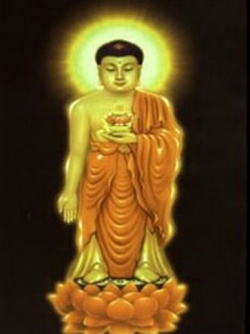Difference between revisions of "The Five Dhyani Buddhas: Amithabha"
| Line 1: | Line 1: | ||
[[File:Han.jpg|thumb|250px|]] | [[File:Han.jpg|thumb|250px|]] | ||
| − | The Five Dhyani Buddhas are icons of Mahayana Buddhism. Each represents a different aspect of enlightened consciousness to aid in spiritual transformation. | + | The [[Five Dhyani Buddhas]] are icons of [[Mahayana Buddhism]]. Each represents a different aspect of [[enlightened]] [[consciousness]] to aid in [[spiritual]] [[transformation]]. |
| − | Amitabha Buddha, who is also called Amita or Amida Buddha, probably is the best known of the Dhyani Buddhas. In particular, devotion to Amitabha is at the center of Pure Land Buddhism, one of the largest schools of Mahayana Buddhism in Asia. | + | [[Amitabha Buddha]], who is also called Amita or [[Amida]] [[Buddha]], probably is the best known of the [[Dhyani Buddhas]]. In particular, devotion to [[Amitabha]] is at the center of [[Pure Land]] [[Buddhism]], one of the largest schools of [[Mahayana Buddhism]] in {{Wiki|Asia}}. |
| − | In long-ago time, Amitabha was a king who renounced his kingdom to become a monk. Called Dharmakara Bodhisattva, the monk practiced diligently for five eons and realized enlightenment and became a buddha. | + | In long-ago [[time]], [[Amitabha]] was a [[king]] who renounced his kingdom to become a [[monk]]. Called [[Dharmakara]] [[Bodhisattva]], the [[monk]] practiced diligently for five eons and [[realized]] [[enlightenment]] and became a [[buddha]]. |
| − | Amitabha Buddha reigns over Sukhavati, the western paradise, also called the Pure Land. Those reborn in the Pure Land experience the joy of hearing Amitabha teach the dharma until they are ready to enter Nirvana. | + | [[Amitabha Buddha]] reigns over [[Sukhavati]], the western [[paradise]], also called the [[Pure Land]]. Those [[reborn]] in the [[Pure Land]] [[experience]] the [[joy]] of [[hearing]] [[Amitabha]] teach [[the dharma]] until they are ready to enter [[Nirvana]]. |
| − | Amitabha symbolizes mercy and wisdom. He is associated with the third skandha, that of perception. Tantric meditation on Amitabha is an antidote to desire. He is sometimes pictured in between the bodhisattvas Avalokiteshvara and Mahasthamaprapta. | + | [[Amitabha]] [[symbolizes]] [[mercy]] and [[wisdom]]. He is associated with the third [[skandha]], that of [[perception]]. [[Tantric]] [[meditation]] on [[Amitabha]] is an antidote to [[desire]]. He is sometimes pictured in between the [[bodhisattvas]] [[Avalokiteshvara]] and [[Mahasthamaprapta]]. |
| − | In this image, Amitabha's hands are in a meditation mudra. His symbol is the lotus, representing gentleness and purity. | + | In this image, Amitabha's hands are in a [[meditation]] [[mudra]]. His [[symbol]] is the [[lotus]], representing [[gentleness]] and [[purity]]. |
{{R}} | {{R}} | ||
Revision as of 23:45, 3 September 2013
The Five Dhyani Buddhas are icons of Mahayana Buddhism. Each represents a different aspect of enlightened consciousness to aid in spiritual transformation. Amitabha Buddha, who is also called Amita or Amida Buddha, probably is the best known of the Dhyani Buddhas. In particular, devotion to Amitabha is at the center of Pure Land Buddhism, one of the largest schools of Mahayana Buddhism in Asia.
In long-ago time, Amitabha was a king who renounced his kingdom to become a monk. Called Dharmakara Bodhisattva, the monk practiced diligently for five eons and realized enlightenment and became a buddha.
Amitabha Buddha reigns over Sukhavati, the western paradise, also called the Pure Land. Those reborn in the Pure Land experience the joy of hearing Amitabha teach the dharma until they are ready to enter Nirvana.
Amitabha symbolizes mercy and wisdom. He is associated with the third skandha, that of perception. Tantric meditation on Amitabha is an antidote to desire. He is sometimes pictured in between the bodhisattvas Avalokiteshvara and Mahasthamaprapta.
In this image, Amitabha's hands are in a meditation mudra. His symbol is the lotus, representing gentleness and purity.
